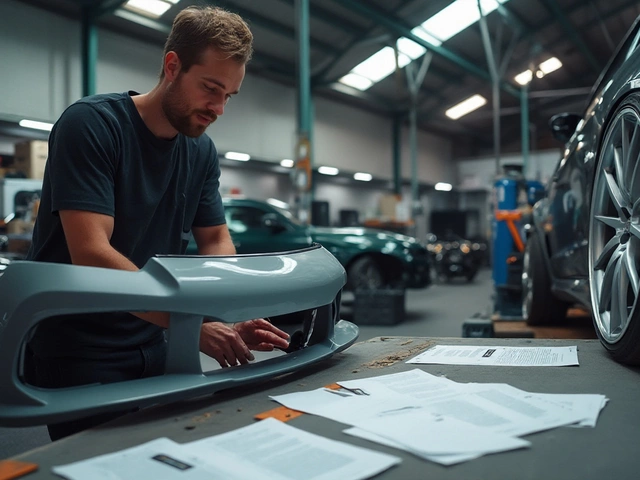Slam your car door in a parking lot and you get a satisfying thud. But fire up the ignition and let the engine purr, and suddenly your mood changes. Plenty of drivers want their ride to sound aggressive, distinctive, or just plain cooler than the neighbor’s. It’s impossible to ignore how much people obsess over exhaust notes—countless forums, YouTube videos, and weekend meetups are filled with talk about this detail. At the center of this debate sits one big, shiny question: do exhaust tips actually change the sound of your car?
The Truth Behind Exhaust Tips and Sound
It’s easy to get caught up in the idea that a set of fat, chrome exhaust pipes mean instant Ferrari volume. But let’s drop the hype and get honest: exhaust tips only affect your car’s sound in rare, specific ways. Standard exhaust tips—especially those that are just extensions—mostly change the way the back of your car looks, not how it sounds. They’re like stylish shoes: they might finish your look, but they don’t make you run faster.
Here’s where it gets interesting. Some tips are designed to amplify or modify the sound. Tips with a larger diameter, those with resonated chambers, or split outlets can give an exhaust note a deeper or sharper edge. But unless your tip radically changes how air vibrates coming out of your muffler, the difference is unlikely to be dramatic. Want a scientific fact? A study run by SEMA (Specialty Equipment Market Association) showed exhaust tips themselves only changed sound pressure level by about one or two decibels, which is barely noticeable to the human ear.
Sound is really made upstream—inside your muffler, resonator, and the actual exhaust pipe. This is where the magic happens for both volume and tone. You’d get more noise swapping your stock muffler for a more open, high-flow one than dropping a hundred bucks on new tip. So what explains all those people swearing they hear a difference? Well, the material and shape can focus sound—sort of like cupping your hand behind your mouth. Some tips make the sound more directional or boost higher frequencies because of their slash-cut shapes or rolled edges. Tips designed with built-in resonators—like those honeycomb mesh inserts—can intentionally create a raspier or more metallic tone. Table below shows how different exhaust tip types can affect sound:
| Tip Type | Material | Effect on Sound |
|---|---|---|
| Standard Straight Cut | Stainless Steel | Minimal or no effect |
| Rolled Edge | Aluminum/Chrome | Makes sound smoother, slightly deeper |
| Resonated | Stainless Mesh | Adds raspy or metallic note |
| Angle Cut | Any | Directs sound, slightly sharper |
Another little-known detail? Size matters—sort of. If you have a tiny engine and slap on a huge 6-inch tip, you won’t get the beefy, throaty growl you’re picturing. You might even get a tinny or “echo-y” sound, because the tip is just too big for the volume of exhaust gases coming through. Car nerds sometimes call this sounding “farty” or hollow. The takeaway? You’ll usually notice a much bigger change in how your car looks than how it sounds.

Why Drivers Swear by Exhaust Tips: Perception vs. Reality
Let’s talk psychology for a second. Plenty of people install a sweet-looking tip, rev the engine, and instantly hear something different. Is this always real, or is it wishful thinking (or hearing)? Turns out, our brains play funny tricks. It’s called the “expectation effect.” Pay for something that promises to change your ride, and you’ll listen extra closely and notice differences you might have ignored before. A test by Car and Driver had everyday drivers do a blind test—factory tips on, then chromed out slash cuts, and nobody reliably picked up obvious changes in sound. Yet, as soon as the drivers knew the tip was upgraded, they were more likely to rate the car as sounding sportier or meaner.
There are real-world exceptions though. If your car’s exhaust runs under the bumper, almost recessed, putting in a longer tip can make the sound seem louder simply because it projects out from under the chassis—meaning, you’re finally hearing some of what was muffled before. I remember a friend who stuck barely-legal tips on his 2015 Mustang; they stuck out another three inches, and suddenly, his neighbors could actually tell when he got home at midnight. Not because the exhaust note changed, but because the sound wasn’t deadened by his rear bumper anymore. And that’s actually a common tip among modders: want people to notice your exhaust sound? Pick a tip length that sticks out past your bumper just a bit (not too far—unless you enjoy knee bruises!).
Some materials even give off subtle vibrations. Stainless tips can slightly amplify higher pitches, gunmetal or titanium can transfer differently, but unless you’re the princess and the pea, it’s pretty minor. Rusty or dented tips, though? They can rattle and buzz at certain RPMs or under hard acceleration, creating odd, embarrassing noises. That’s not a sound enhancement, more like an “I need to fix that” moment. Here’s a quick tip: if you do swap in a new tip and you notice rattling, double check that both the tip and any clamps are snug—loose tips sound awful and can actually stress your exhaust mounts down the line.
The car community is full of anecdotes—some swear exhaust tips made their daily drive’s sound deeper. What usually happened was they also swapped mufflers or deleted resonators before, or just got a tip designed to channel the exhaust out past the bodywork. Plain and simple: your ears might convince you the tip did all the work, but the truth is usually somewhere in the middle.

Choosing and Installing Exhaust Tips: What Actually Matters
So you still want the look (and maybe the small sound tweak) of aftermarket tips? Here’s what actually makes a difference. First, fit the tip to your car’s existing exhaust pipe. Too big, and you’ll get weird overtones and possible vibration. Too small—and, well, it won’t go on at all. Most tips attach with bolts, clamps, or sometimes welds; if you’re not handy with a wrench or don’t like the idea of sparks near your gas tank, clamp-on tips are way easier for DIY jobs.
Next up, material. Stainless steel resists rust best, chrome plating looks flashiest, black tips disappear visually if you want stealth. Titanium tips exist, but unless you race, the price is overkill just for a daily. You can polish these tips every year to keep them shiny or let them develop that used “patina.” If you’ve ever seen a blue-tinged tip on a car, that’s heat discoloration—totally normal with regular use, and kind of a badge of honor to some car nuts.
Think about shape, too. Rolled edges give a more finished look and sometimes slightly lower the tone (because the sound waves don’t just “fall out” of the pipe). Slash-cut tips—angled at the exit—might make the sound point toward the ground or to the side, especially useful if you want to avoid bouncing noise off nearby walls (Emily, my wife, can’t stand when my garage echoes back every time I start my WRX, so I pay attention to where my exhaust points).
If you’re after a real, dramatic difference in noise, you’re better off spending your money elsewhere. High-flow mufflers, resonator deletions, or even switching up the pipe diameter creates much more dramatic changes. Want something throatier? Look for a ‘straight-through’ muffler. Want rasp? Those resonated tips can help—but be ready for some metallic buzz at higher speeds. And don’t forget the law: some states or city codes regulate acceptable decibel levels. That sweet growl you want could hand you a $200 ticket if it registers too loud. The California Vehicle Code, for example, limits cars to 95 dB at specific RPMs.
Installation isn’t rocket science, but a few things can ruin your day. Never install a tip near plastic bumper parts unless you’re sure it’ll clear when hot—nobody wants a melted rear bumper. Double check alignment, so you don’t wind up with an exhaust tip crooked or pointing into your tire. And measure your existing outlet: tailpipe diameters usually run from 1.75" to 3.5" on factory cars, while the tip’s inlet needs to either snug or clamp down to your size. Measure twice, buy once.
Here’s a checklist if you want to upgrade your exhaust tip safely and stylishly:
- Check your car’s tailpipe diameter and length before buying
- Decide on your desired appearance: chrome, matte, color-burned, carbon fiber, etc.
- Pick a mounting style: clamp-on for easy install, weld-on for a permanent fit
- Consider sound features: resonated tips add higher frequencies, rolled edges smooth the noise
- Ensure clearance from bumpers and hangers; leave room for expansion when hot
- Install with quality clamps or professional welding, especially on bigger tips
- Test for rattles or buzzing at different RPMs after install
The next time your buddy claims his new stainless tips made his four-banger sound like a V8, you’ll know the real science behind it. Or maybe just let him have his pride—sometimes we all need a little boost in the driveway battles.




